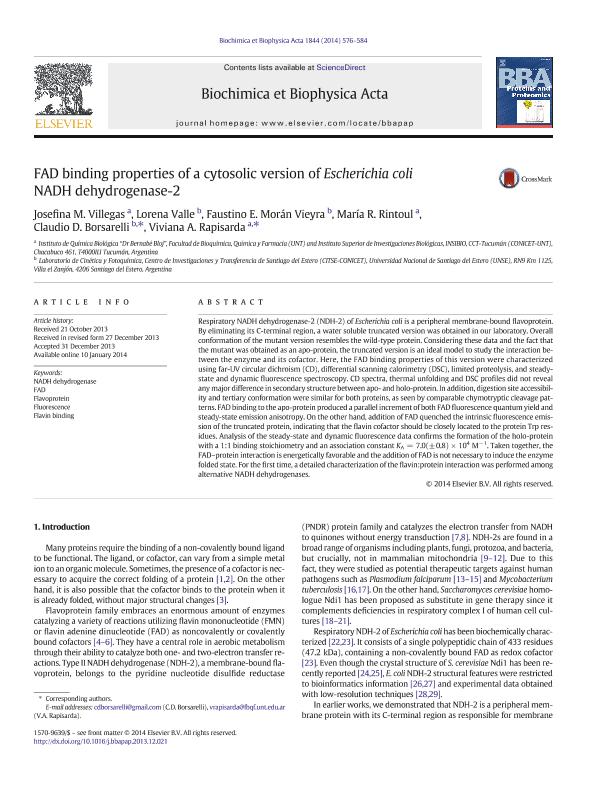Artículo
FAD binding properties of a cytosolic version of Escherichia coli NADH dehydrogenase-2
Villegas, Josefina Maria ; Valle, Lorena; Moran Vieyra, Faustino Eduardo
; Valle, Lorena; Moran Vieyra, Faustino Eduardo ; Rintoul, Maria Regina; Borsarelli, Claudio Darío
; Rintoul, Maria Regina; Borsarelli, Claudio Darío ; Rapisarda, Viviana Andrea
; Rapisarda, Viviana Andrea
 ; Valle, Lorena; Moran Vieyra, Faustino Eduardo
; Valle, Lorena; Moran Vieyra, Faustino Eduardo ; Rintoul, Maria Regina; Borsarelli, Claudio Darío
; Rintoul, Maria Regina; Borsarelli, Claudio Darío ; Rapisarda, Viviana Andrea
; Rapisarda, Viviana Andrea
Fecha de publicación:
03/2014
Editorial:
Elsevier Science
Revista:
Biochimica Et Biophysica Acta-proteins And Proteomics
ISSN:
1570-9639
Idioma:
Inglés
Tipo de recurso:
Artículo publicado
Clasificación temática:
Resumen
Respiratory NADH dehydrogenase-2 (NDH-2) of Escherichia coli is a peripheral membrane-bound flavoprotein. By eliminating its C-terminal region, a water soluble truncated version was obtained in our laboratory. Overall conformation of the mutant version resembles the wild-type protein. Considering these data and the fact that the mutant was obtained as an apo-protein, the truncated version is an ideal model to study the interaction between the enzyme and its cofactor. Here, the FAD binding properties of this version were characterized using far-UV circular dichroism (CD), differential scanning calorimetry (DSC), limited proteolysis, and steadystate and dynamic fluorescence spectroscopy. CD spectra, thermal unfolding and DSC profiles did not reveal any major difference in secondary structure between apo- and holo-protein. In addition, digestion site accessibility and tertiary conformation were similar for both proteins, as seen by comparable chymotryptic cleavage patterns. FAD binding to the apo-protein produced a parallel increment of both FAD fluorescence quantumyield and steady-state emission anisotropy. On the other hand, addition of FAD quenched the intrinsic fluorescence emission of the truncated protein, indicating that the flavin cofactor should be closely located to the protein Trp residues. Analysis of the steady-state and dynamic fluorescence data confirms the formation of the holo-protein with a 1:1 binding stoichiometry and an association constant KA = 7.0(±0.8) × 104 M−1. Taken together, the FAD?protein interaction is energetically favorable and the addition of FAD is not necessary to induce the enzyme folded state. For the first time, a detailed characterization of the flavin:protein interactionwas performed among alternative NADH dehydrogenases.
Palabras clave:
NAPDH DEHYDROGENASE
,
FAD
,
FLAVOPROTEIN
,
FLUORESCENCE
,
FLAVIN BINDING
Archivos asociados
Licencia
Identificadores
Colecciones
Articulos(CERELA)
Articulos de CENTRO DE REFERENCIA PARA LACTOBACILOS (I)
Articulos de CENTRO DE REFERENCIA PARA LACTOBACILOS (I)
Articulos(INSIBIO)
Articulos de INST.SUP.DE INVEST.BIOLOGICAS
Articulos de INST.SUP.DE INVEST.BIOLOGICAS
Articulos(SEDE CENTRAL)
Articulos de SEDE CENTRAL
Articulos de SEDE CENTRAL
Citación
Villegas, Josefina Maria; Valle, Lorena; Moran Vieyra, Faustino Eduardo; Rintoul, Maria Regina; Borsarelli, Claudio Darío; et al.; FAD binding properties of a cytosolic version of Escherichia coli NADH dehydrogenase-2; Elsevier Science; Biochimica Et Biophysica Acta-proteins And Proteomics; 1844; 3; 3-2014; 576-584
Compartir
Altmétricas



